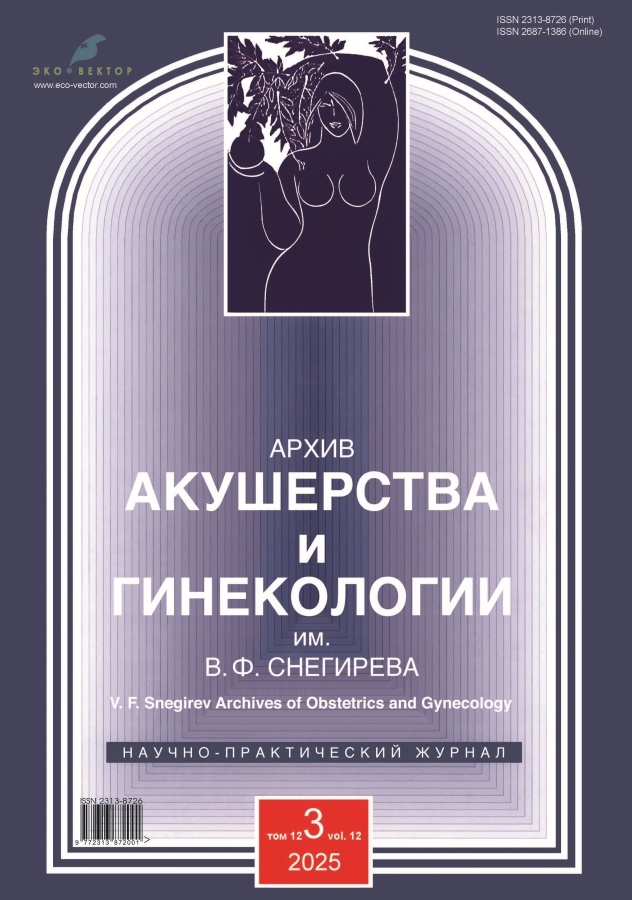放射性诱导阴道狭窄女性治疗前后性功能的比较研究
- 作者: Gubanova E.G.1, Yashchuk A.G.1, Musin I.I.1, Battalova G.Y.1
-
隶属关系:
- Bashkir State Medical University
- 期: 卷 12, 编号 3 (2025)
- 页面: 317-325
- 栏目: Original study articles
- URL: https://bakhtiniada.ru/2313-8726/article/view/350244
- DOI: https://doi.org/10.17816/aog676889
- EDN: https://elibrary.ru/QZDALD
- ID: 350244
如何引用文章
详细
论证:放射性诱导阴道狭窄是根治性盆腔手术及放化疗后常见的并发症之一,对女性性功能造成持续性负面影响,因此亟需解决为患者提供帮助的问题。
目的:采用“女性性功能指数”(Female Sexual Function Index)问卷,评估放射性诱导阴道狭窄患者在个体化治疗前后的性满意度。
材料与方法:本研究共纳入25名女性,其中10例为放射性诱导阴道狭窄患者,接受透明质酸联合扩张疗法(第1组);5例患者需要手术治疗,行Martius–Symmonds皮肤–肌肉–脂肪瓣阴道重建术(第2组);另有10例女性构成对照组(第3组)。
结果:评估了“女性性功能指数”的六个领域:性欲、性唤起、润滑、性高潮、性生活满意度及性交疼痛。治疗前,第1组和第2组的总评分低于对照组,同时性功能障碍的严重程度对应于较低水平的指标。治疗后,第1组所有指标均有提高,其中“性唤起”(5.13±0.29)和“性生活满意度”(4.52±0.41)得分最高,其次依次为性高潮(5.00±0.43)、性欲(4.80±0.45)、润滑(4.80±0.32)及性交疼痛(4.20±0.39)。第2组治疗后,性生活满意度指标最高3.92±0.65,性高潮得分为3.84±0.44。其他领域的得分依次为:润滑3.48±0.68、性欲3.48±0.97、性唤起3.48±1.01和性交疼痛3.04±1.30。
结论:研究结果可作为进一步探索放射性诱导阴道狭窄治疗方法的推动力,并进而改善女性性生活质量。
关键词
作者简介
Elena G. Gubanova
Bashkir State Medical University
编辑信件的主要联系方式.
Email: ekaz4ntseva@yandex.ru
ORCID iD: 0000-0003-0855-7754
SPIN 代码: 8566-4281
俄罗斯联邦, 3 Lenin st, Ufa, 450008
Alfiya G. Yashchuk
Bashkir State Medical University
Email: alfiya_galimovna@mail.ru
ORCID iD: 0000-0003-2645-1662
SPIN 代码: 2607-9150
MD, Dr. Sci. (Medicine), Professor
俄罗斯联邦, 3 Lenin st, Ufa, 450008Ilnur I. Musin
Bashkir State Medical University
Email: ilnur-musin@yandex.ru
ORCID iD: 0000-0001-5520-5845
SPIN 代码: 4829-1179
MD, Dr. Sci. (Medicine), Professor of the Department
俄罗斯联邦, 3 Lenin st, Ufa, 450008Gyuzel Yu. Battalova
Bashkir State Medical University
Email: guzel.batt@mail.ru
ORCID iD: 0000-0002-1641-9952
MD, Dr. Sci. (Medicine), Professor of the Department
俄罗斯联邦, 3 Lenin st, Ufa, 450008参考
- Kachnic LA, Bruner DW, Qureshi MM, Russo GA. Perceptions and practices regarding women's vaginal health following radiation therapy: A survey of radiation oncologists practicing in the United States. Pract Radiat Oncol. 2017;7(5):356–363. doi: 10.1016/j.prro.2017.02.003
- Bonner C, Nattress K, Anderson C, et al. Chore or priority? Barriers and facilitators affecting dilator use after pelvic radiotherapy for gynaecological cancer. Support Care Cancer. 2012;20(10):2305–2313. doi: 10.1007/s00520-011-1337-z
- Miles T, Johnson N. Vaginal dilator therapy for women receiving pelvic radiotherapy. Cochrane Database Syst Rev. 2014;2014(9):CD007291. doi: 10.1002/14651858.cd007291.pub3
- Brand A, Bull C, Cakir B. Vaginal stenosis in patients treated with radiotherapy for carcinoma of the cervix. Int J Gynecol Cancer. 2006;16(1):288–293. doi: 10.1111/j.1525-1438.2006.00348.x
- Yoshida K, Yamazaki H, Nakamura S, et al. Role of vaginal pallor reaction in predicting late vaginal stenosis after high-dose-rate brachytherapy in treatment-naive patients with cervical cancer. J Gynecologic Oncology. 2015;26(3):179–184. doi: 10.3802/jgo.2015.26.3.179
- Denton AS, Maher J. Interventions for the physical aspects of sexual dysfunction in women following pelvic radiotherapy. Cochrane Database Syst Rev. 2003;2003(1):CD003750. doi: 10.1002/14651858.CD003750
- Katz A, Njuguna E, Rakowsky E, et al. Early development of vaginal shortening during radiation therapy for endometrial or cervical cancer. Int J Gynecol Cancer. 2001;11(3):234–235. doi: 10.1046/j.1525-1438.2001.01019.x
- Brotto L, Atallah S, Johnson-Agbakwu C, et al. Psychological and interpersonal dimensions of sexual function and dysfunction. J Sex Med. 2016;13(4):538–571. doi: 10.1016/j.jsxm.2016.01.019
- Basson R, Berman J, Burnett A, et al. Report of the international consensus development conference on female sexual dysfunction: definitions and classifications. J Urol. 2000;163(3):888–893.
- Basson R. Using a different model for female sexual response to address women's problematic low sexual desire. J Sex Marital Ther. 2001;27(5):395–403. doi: 10.1080/713846827
- Stahl J, Qian J, Tien C, et al. Extended duration of dilator use beyond 1 year may reduce vaginal stenosis after intravaginal high-dose-rate brachytherapy. Support Care Cancer. 2019;27(4):1425–1433. doi: 10.1007/s00520-018-4441-5
- Owen M. International clinical guideline group. International guidelines on vaginal dilation after pelvic radiotherapy. In: National Forum of Gynaecological Oncology Nurses. Oxon, UK; 2012.
- Matos S, Lucas Rocha Cunha M, Podgaec S, et al. Consensus for vaginal stenosis prevention in patients submitted to pelvic radiotherapy. Plos One. 2019;14(8):e0221054. doi: 10.1371/journal.pone.0221054
- Necas J, Bartosikova L, Brauner P, Kolar J. Hyaluronic acid (hyaluronan): a review. Veterinarni Medicina. 2008;53(8):397–411. doi: 10.17221/1930-VETMED
- Rothenberger R, Feroz R, Hogarth N, et. al. Ideal incision and dissection for martius flap: a cadaver-based study on nerve and vascular density. American Journal of Obstetrics and Gynecology. 2024;230(4):S1225–S1226. doi: 10.1016/j.ajog.2024.02.130
- Damast S, Jeffery D, Son C, et al. Literature review of vaginal stenosis and dilator use in radiation oncology. Pract Radiat Oncol. 2019;9(6):479–491. doi: 10.1016/j.prro.2019.07.001
补充文件







